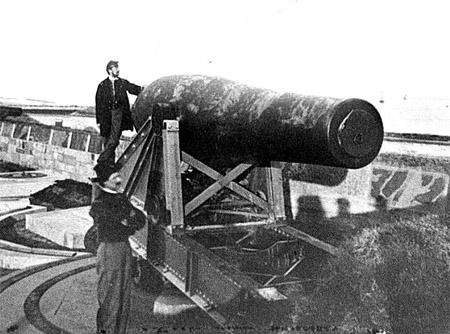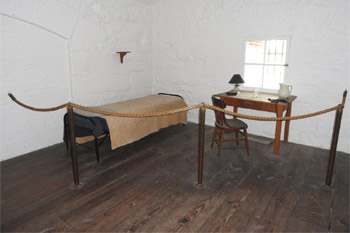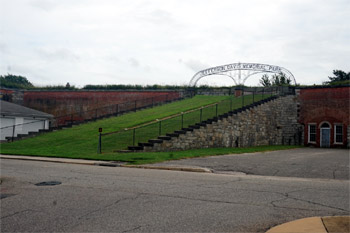 |
Fort Monroe
Hampton, Virginia, USA
|
|
 |
Constructed: 1819 - 1834
Used by: United States
Designed by: Simon Bernard
Conflict in which it participated:
US Civil War
|
The spot on which Fort Monroe now proudly stands was first identified as a strategic location by the earliest English settlers in America in 1607: They settled 25 miles inland at Jamestown, but built Fort Algernourne at this location in 1609 to protect the colony's approaches. Several other fortifications were built here, but it wasn't until the lessons learned from the War of 1812 (such as the British putting Washington DC to the torch!) were taken to heart that the authorities got serious, and con-
|
 |
|
|
struction on the current (and quite pointily lovely) fort was begun in 1819, and completed in 1834...named, as one might imagine, for President James Monroe (1758-1831). Fort Monroe was designed by French military engineer Simon Bernard (1779-1839), who had served as aide-de-camp to Napoleon (1769-1821), and was thus less than popular with the post-Napoleon monarchy in France. Bernard was ejected from his homeland in 1815 but landed on his feet in the fledgling US, where President James Monroe was looking to bolster US seacoast defenses. Bernard would eventually design other notable US starforts, such as Fort Adams in Newport, RI and Fort Macon in North Carolina, among many others.
|
 The Lincoln Gun, the first 15-inch Rodman Gun, mounted at Fort Monroe during the US Civil War. Click here to see the gun as it sits today! The Lincoln Gun, the first 15-inch Rodman Gun, mounted at Fort Monroe during the US Civil War. Click here to see the gun as it sits today! |
 |
Though Virginia was most definitely Confederate territory during the American Civil War (1861-1865), the federal government held on to Fort Monroe. Fort Monroe was in fact one of only four southern US forts which the federal government retained through the war, the others being Fort Jefferson, Fort Pickens and Fort Zachary Taylor, all in Florida. This not only helped to extend Union control over the coast of the Carolinas, but served as a staging ground for several land campaigns against the rebels. In May of 1862, Fort Monroe's commander, Major General Benjamin Butler (1818-1893), announced that black slaves who |
|
managed to make their way to Union lines would be considered "contraband," which would prevent their having to be returned to their previous owner. This automatically freed these slaves, which made Fort Monroe, smack in the heart of the Confederacy, a popular destination for running slaves. By the end of the war around 10,000 slaves had presented themselves to be "contraband," and several "contraband camps" were built to house them.
After the war, former Confederate President Jefferson Davis (1808-1889) spent two years as a prisoner at Fort Monroe. His incarceration was harsh at first, as he was kept chained in an open casemate with four guards constantly scrutinizing him lest he burst through his confining brick walls, but after a few months Davis' doctor managed to convince Fort Monroe's commanding officer, General Nelson A. Miles (1839-1925), that this was as ridiculous as it was pointless.
   Left: Jefferson Davis' personal casemate at Fort Monroe for the early period of his incarceration: How lucky can a guy get? Left: Jefferson Davis' personal casemate at Fort Monroe for the early period of his incarceration: How lucky can a guy get?
Right: Jefferson Davis' relationship with Fort Monroe is a complicated one. Being in the south as it is, and local sympathies being what they were (and frequently are), the ex-President of the CSA is remembered more fondly at Fort Monroe than he likely is at Fort Adams. The Jefferson Davis Memorial Park was dedicated in May of 1956, with the iron arch donated by the United Daughters of the Confederacy.
While many in the north wished for Davis to suffer greatly for his wicked, treasonous misdeeds, the federal government didn't really have any intention of torturing the guy. Davis was moved to plushier digs within the fort, and eventually his family was allowed to join him: He was even given permission to walk unattended around the fort in the evenings. Davis was released on $100,000 bail in 1867, having never gone to trial.
Fort Monroe was on the front line of America's imagined vulnerability to seaborne invaders after the Civil War. Every cockamamie artillery scheme that was dreamed up by the fertile minds of the military establishment was installed and tested at Fort Monroe, particularly focusing on the Endicott Period of the 1890's: A great many extra, hideously ugly concrete batteries were built around Fort Monroe, in the interest of defending the all-important Hampton Roads area from the completely imaginary Spanish/German/Whomever threat.
|
Fort Monroe did escape the fate of many US starforts that were defaced with millions of tons of concrete during the Endicott Period, however: Take a look at poor Fort Delaware to see what could have been the case. Since the Second World War (1939-1945), Fort Monroe has served the US as a training facility: Starting in 1973 the army's Training and Doctrine Command called Fort Monroe home. Fort Monroe ceased being a military entity in September of 2011. Today it's an absolutely FABULOUS spot which to visit and poke around. The Casemate Museum is world-class...have you deduced that I've visited Fort Monroe? |
 |
|
|
|
|
|
|
|
|
 |




